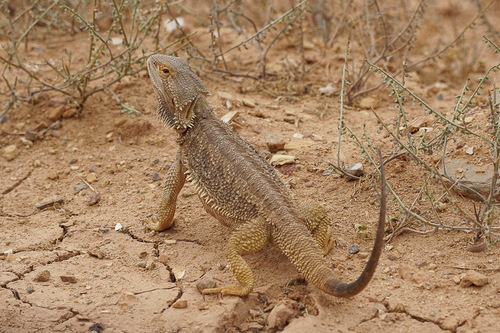
Central Bearded Dragon
The central bearded dragon (Pogona vitticeps) thrives in Australia's arid landscapes, showcasing a spiny 'beard' that darkens during displays. Known for their social signals, these omnivores bask in the sun, playing a vital role in the ecosystem. Watch for their unique arm-waving and head-bobbing behaviors!
6-15 years
Lifespan
250.0 - 510.0 g
Weight
Length: 50 - 61 cm
Size
Brown, Grey, Yellow, Green
Color
25 mph
Top Speed
Least Concern
Conservation Status
Unknown
Population Trend
Characteristics
Pogona vitticeps, commonly known as the central bearded dragon, is a reptile native to arid regions of Australia. It exhibits a distinctive 'beard' of spiny scales under its throat, which can darken during displays. These diurnal creatures are omnivorous, basking in sunlight to regulate their body temperature, and display unique social behaviors like arm-waving and head-bobbing.
Distribution Range of the Central Bearded Dragon
Pogona vitticeps, commonly known as the central bearded dragon, is native to the arid and semi-arid regions of central Australia. It is predominantly found in the states of Queensland, New South Wales, South Australia, and the Northern Territory.
Central Bearded Dragon's Habitat
Environmental Conditions
The central bearded dragon inhabits a range of environments that typically include deserts, dry forests, and scrublands. These areas are characterized by low rainfall, high temperatures, and sparse vegetation. The species is well-adapted to these harsh conditions, often found in open woodlands, rocky deserts, and arid shrublands.
Ecological Niche
Pogona vitticeps occupies an ecological niche as both a predator and prey. It is an omnivorous species, feeding on a variety of insects, small animals, and vegetation. Its ability to tolerate wide temperature ranges and its behavioral adaptations, such as basking to regulate body temperature, make it well-suited to its native habitat. The bearded dragon also plays a role in controlling insect populations and serves as prey for larger predators.
Copyright @ Nature Style Limited. All Rights Reserved.
 English
English